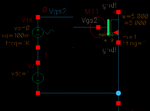viperpaki007
Full Member level 5

- Joined
- Jul 2, 2008
- Messages
- 274
- Helped
- 11
- Reputation
- 22
- Reaction score
- 8
- Trophy points
- 1,298
- Location
- Finland
- Activity points
- 3,437
Hi,
How can i simulate the values of Oxide capacitance (Cox) and mobility of charge carriers in NMOS and PMOS in cadence. These values are not provided in process design kit file.
regards
How can i simulate the values of Oxide capacitance (Cox) and mobility of charge carriers in NMOS and PMOS in cadence. These values are not provided in process design kit file.
regards


